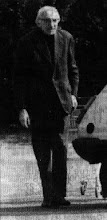In the Critique of Pure Reason Kant draws a distinction between negative and indefinite judgment. As Slavoj Zizek has pointed out, the example that Kant uses is very telling in the context of the un-dead: the positive judgment, by which a predicate is ascribed to a subject (S is P), is given as ‘the soul is mortal’; the negative judgment, by which a predicate is denied to a subject (S is not P), is given as ‘the soul is not mortal’, while the indefinite judgment, in which a certain non-predicate is affirmed (S is not-P), is given as ‘the soul is not-mortal’. The difference between the negative and the indefinite judgment thus appears as a matter of spacing. All this has an immediate bearing on the notion of the un-dead, or the living dead. As Zizek has also indicated, we resort to indefinite judgments in our ordinary language, exactly ‘when we endeavour to comprehend those borderline phenomena that undermine established differences such as that between living and being dead’. The same argument applies to the notion of the uncanny, which Freud similarly derives as an indefinite judgment, based on a consideration of the derivation of the word unheimlich and its relation to heimlich. (Nicholas Royle has shown that a similar relation holds between ‘canny’ and ‘uncanny’ in English.) The un-dead, that is, uncanny creatures such as vampires, zombies and so on, are neither alive nor dead: ‘he is un-dead’ thus is a perfect example of the indefinite judgment, inasmuch as vampires are excluded from the domain of the living without therefore being included in the domain of the dead. The un-dead retain the characteristics of a living creature, without being one. As Freud saw the matter, the uncanny pertains to all that was intended to remain secret, hidden away, but which has, nevertheless, come into the open. As Hal Foster has shown, the uncanny, with its attendant notions of repetition, the death drive and doubling, is as fundamental to the procedures of surrealism as it is to the horror film. The uncanny does not oppose the world; it hollows it out from within, opening it towards an abyss. The return from the grave of the un-dead is the appearance of something profoundly other, something that blurs the distinction between imagination and reality, between the symbol and what is symbolised. The vampire is an unrepresentable Thing, and the space he occupies is neither that of community nor that of society. The vampire occupies an uncanny space that Lacan called ‘l’entre-deux-morts’, between two deaths, a a gap between the Symbolic and the Real. For Lacan, it is what dwells here that is the ultimate object of horror.
A film that gives an overwhelming sense of this order of horror is Dreyer’s Vampyr. A similar order of experience is evident in Murnau’s Nosferatu. The film ends as Nina Harker sacrifices herself to save the city of Bremen. Jonathan rushes into the bedroom and embraces her, only for her to sink back and die. What one can say is that Nina is only able to destroy the vampire if she is willing to join him in that space between two deaths, and this she does, in her passivity, for all the time during the night while he remains beside her, bent low over her neck. It is the book Jonathan returned with, the Book of the Vampires, that has brought Nina to this condition: in other words, it is the Symbolic order itself, as represented by the book, an order that stands for death, in the sense of mortifying the Real of the body, that brings her to that which eludes symbolisation. As does Dreyer, Murnau associates the vampire with the very film that we are watching. Both films present us with issues of representation and meaning as they are inflected by the death drive, a force that, neither living nor dead, partakes of the demonic.
CINDERELLA’S ASHTRAY
a little shoe was part of it
finality
a slippage without cause
which I think was traced already
in my childhood
an image that should have stayed concealed
a sound one ought never to have heard again
the object
of objective chance
is a hole made of lilies
*
I must retrace my steps
the street’s deserted
the door open
a gold branch hangs above the stairwell
a sliver of crystal twists in a moulding of white sand
a woman pledged herself one day in that same space
a copper wire conducts the light
*
I attach no importance to it
it accords no significance to me
the plaster figures have lost nothing of their expression
the tears I shed are not mine
Tuesday, 5 April 2011
Subscribe to:
Post Comments (Atom)



No comments:
Post a Comment